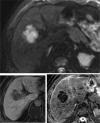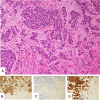Rare paracholedochal lymph node metastasis in lung cancer
- PMID: 40313372
- PMCID: PMC12041744
- DOI: 10.1093/jscr/rjaf260
Rare paracholedochal lymph node metastasis in lung cancer
Abstract
Lung cancer remains the leading cause of cancer-related mortality worldwide. Common metastatic sites include the liver, bones and adrenal glands, while intra-abdominal lymph node metastases (ALNM) are less frequently recognized and often underestimated. Non-small cell lung cancer (NSCLC) accounts for 85% of lung cancer cases. Gastrointestinal and intra-ALNM are rare but likely underdiagnosed, with hematogenous and lymphatic pathways, including the thoracic duct, playing key roles. ALNM occurs in 6%-11% of NSCLC patients, with the porta hepatis being an exceptionally rare site. Advanced staging and follow-up are crucial for detecting ALNM, as they impact prognosis and therapy. Positron emission tomography/computed tomography (PET/CT) has shown superior sensitivity compared to CT in detecting extrathoracic metastases, influencing management in up to 25% of NSCLC cases. Here, we present the case of a NSCLC patient with a paracholedochal lymph node metastasis and explore various metastatic pathways emphasizing the pivotal role of PET/CT imaging.
Keywords: abdominal lymph node metastasis; choledochus; hepatoduodenal ligament; non-small cell lung cancer; staging PET/CT.
Published by Oxford University Press on behalf of JSCR Publishing Ltd 2025.
Conflict of interest statement
None declared.
Figures


Similar articles
-
Abdominal lymph node metastasis by lymphatic spread through the thoracic duct in patients with non-small-cell lung cancer.Thorac Cancer. 2021 Jul;12(14):2078-2084. doi: 10.1111/1759-7714.14014. Epub 2021 May 25. Thorac Cancer. 2021. PMID: 34033231 Free PMC article.
-
An Investigation of the Relationship Between 18F-FDG PET/CT Parameters of Primary Tumors and Lymph Node Metastasis in Resectable Non-small Cell Lung Cancer.Curr Radiopharm. 2024;17(1):111-116. doi: 10.2174/1874471016666230829100703. Curr Radiopharm. 2024. PMID: 37644744
-
Predicting non-small cell lung cancer lymph node metastasis: integrating ctDNA mutation/methylation profiling with positron emission tomography-computed tomography (PET-CT) scan: protocol for a prospective clinical trial (LUNon-invasive Study).J Thorac Dis. 2024 Sep 30;16(9):6272-6285. doi: 10.21037/jtd-24-1033. Epub 2024 Sep 26. J Thorac Dis. 2024. PMID: 39444874 Free PMC article.
-
Undetected lymph node metastases in presumed early stage NSCLC SABR patients.Expert Rev Anticancer Ther. 2016 Aug;16(8):869-75. doi: 10.1080/14737140.2016.1199279. Epub 2016 Jun 20. Expert Rev Anticancer Ther. 2016. PMID: 27279087 Review.
-
Preoperative intrathoracic lymph node staging in patients with non-small-cell lung cancer: accuracy of integrated positron emission tomography and computed tomography.Eur J Cardiothorac Surg. 2009 Sep;36(3):440-5. doi: 10.1016/j.ejcts.2009.04.003. Epub 2009 May 22. Eur J Cardiothorac Surg. 2009. PMID: 19464906 Review.
References
Publication types
LinkOut - more resources
Full Text Sources

